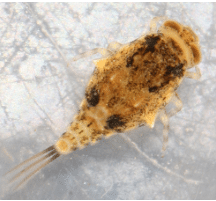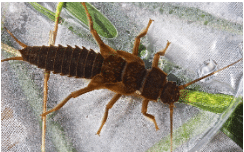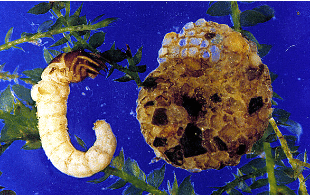
Benthic macroinvertebrates (BMI; no, not body mass index) are aquatic animals without backbones that are large enough to see without a microscope. They include worms, crustaceans, and immature forms of aquatic insects such as mayfly and stonefly nymphs and caddisfly larvae. BMI can be important indicators of water quality. Unlike fish, these organisms are not very mobile and are therefore less able to escape the effects of pollution and sedimentation. Many species of mayfly nymphs, stonefly nymphs, and caddisfly larvae are not very tolerant of pollution and can only survive in swift, cool, well-oxygenated water. Their presence is generally interpreted as a sign of good water quality.
One important index often used for water quality rating of perennial streams is the EPT index. This acronym stands for Ephemeroptera, Plecoptera, and Trichoptera, insect taxonomic orders for mayflies, stoneflies, and caddisflies, respectively. The abundance and richness of EPTs are very useful in determining water quality classification.
The mayfly order, Ephemeroptera, is Greek for “short-lived winged” referring to the short-lived adult lifespan, usually less than 24 hours for some species. The nymphs are characterized by having well-developed abdominal plate-like gill filaments and usually 3 but sometimes 2 well-developed caudal filaments (cerci). The representative “E” featured in this post below is from the Baetiscidae family within the only genus, Baetisca. This genus is widespread east of the Rockies and somewhat pollution intolerant in the Southeastern United States. Up to 10 different species have been identified in the Southeastern U.S. These “armored” mayflies are sprawlers and clingers found in lotic-depositional habitat and feed by collecting or scraping live organic matter. Note the armored head and thoracic sections with spines that aid in burrowing and protection in depositional areas.

The stonefly order, Plecoptera, is Greek for “folded or pleated winged” referring to the adults’ wing arrangement. Stoneflies are the least pollution tolerant of the EPT group and are found in cold, fast-moving, highly oxygenated streams and rivers, usually in leaf packs or under stones, hence their namesake. While stonefly nymphs can be confused with mayfly nymphs, stonefly nymphs do not have the plate-like abdominal gills, only have 2 caudal filaments, and exhibit two tarsal claws versus one tarsal claw for mayflies. The representative “P” featured in this post below is from the Pteronarcyidae family (the giant or salmonfly stoneflies) in the genus Pteronarcys. These giant stoneflies are sprawlers and clingers found in both lotic-depositional and lotic-erosional habitats and feed mostly as shredders of living and decaying organic matter. They are also known to be a part of the scraper/grazer and engulfer/predator feeding guilds.

The caddisfly order, Trichoptera, is Greek for “hair wings” in reference to the hairs covering the wings of adults. Caddisflies inhabit a wide range of habitats such as streams, rivers, lakes and ponds. Many caddisfly larvae are known for their ability to make cases out of sand, pebbles, or plant matter using sticky homespun silk. Others are free-living or use miniature silken seine nets or tubes to help capture food. The representative “T” featured in this post below is from the family Helicopsychidae (snail casemakers) within the only genus, Helicopsyche. Historically these caddisflies were originally described as snails that were able to glue sand grains to cover and strengthen their whirls. Larvae of Helicopsyche are typically found in running water but also are found in littoral zone of lakes. They are scraper/grazers primarily feeding on diatoms and detritus.

The Ephemeroptera, Plecoptera, and Trichoptera (EPT) group is an extremely diverse group with which it is very fun to work. As becoming familiar with this group is very important if one wants to perform water quality assessment of streams, it is recommended that one take as many workshops as possible to further understanding of these benthic macroinvertebrates. Be on the lookout for additional posts on these creatures in the future.
Sources Used
Larvae of the North American Caddisfly Genera (Trichoptera), 2nd edition. Wiggins, Glenn B. 1996. University of Toronto Press, Toronto, Ontario, Canada.
Larvae of the Southeastern USA: Mayfly, Stonefly, and Caddisfly Species (Ephemeroptera, Plecoptera, and Trichoptera). Morse, John C., et. al. 2017. Clemson University Public Service Publishing, Clemson, South Carolina.
Macroinvertebrates.org
Nymphs of North American Stonefly Genera (Plecoptera), 2nd edition. Stewart, Kenneth W. and Bill P. Stark. 2002. The Caddis Press, Columbus, Ohio.
